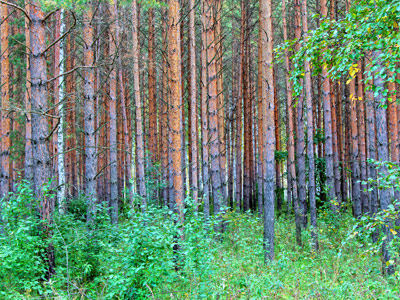
Management and Use of Coniferous Forests
This GCSE Geography quiz will test you on the management and use of coniferous forests. Wood has always been an important resource for humans and large areas of our planet have already been severely deforested because of unsustainable use of trees. As the population of the Earth has increased and our understanding of how the natural world works has expanded, it has been realised that our remaining forests need to be carefully managed if they are to continue to supply us with wood in the future.
The Northern Coniferous Forest stretches in a belt around the Northern Hemisphere from Alaska, through Canada and the USA, Scandinavia and Siberian Russia and is our main source of softwood and wood pulp for paper making. There are other coniferous forests, for example the Pacific Coast Forest in North America and the Caledonian Forest (or at least what is left of it) in Scotland.
Unlike deciduous forests, coniferous forests are made up from very few tree species (pine, spruce, fir and larch) and the floor of the forest supports little vegetation. The soil is thin, acidic and low in nutrients. The species of trees are well-adapted to very cold winters with a lot of snow and short warm summers with long hours of daylight.
The coniferous forests that supply wood are usually managed in a sustainable way with controlled logging taking only mature trees, followed by replanting of the areas that have been logged. In some places, the tree trunks are stripped of their branches and then floated down large rivers as huge rafts to reach the saw mills. This is a very environmentally-friendly way of transporting the logs.
Since coniferous forests are located in cold regions, harvesting can be carried out in the winter, when the ground is frozen, making it easier to get machinery in and the logs out. Forestry can provide valuable local employment but in countries such as Canada, where logging is run by large companies, this is not the case.
Scotland was once covered in forest but the trees have been cleared by thousands of years of human habitation. Only a few small areas of this forest now remain. But if you visit Scotland, you will see quite a lot of coniferous forests - these have been planted since the start of the 20th century by the Forestry Commission. They are a cash crop and trees are continually harvested by clear felling whole sections of the forest then replanting to ensure they are sustainable. The trees mature in 40 - 50 years rather than the longer timescales for hardwoods.
In addition to commercial logging, Forestry Commission forests are used for recreation. The forestry tracks allow easy access for cyclists and walkers and in some places they are used for professional car rallies e.g. in Wales and Kielder Forest in the north East of England. In the Southern Uplands of Scotland, mountain bike trails and visitor centres have been developed.
Softwood is extensively used in construction and most modern houses have floors, floor joists, floorboards, door frames, doors etc that have been made from some form of softwood. Fencing and decking materials in the garden are most often also made from softwoods like Douglas pine and spruce. Inexpensive furniture is also made using the softwood from coniferous forests - it is considerably cheaper and much easier to work than hardwoods like oak and beech. Almost half of the World's production of softwood goes for papermaking.
Ready for more?
not all...
quizzers. Try to win a coveted spot on our Hall of Fame Page.







